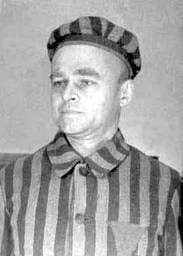It was an idea thatcarried the greatest possible danger.
 |
| Prisoner Number 4859: Pilecki |
In the autumn of1940, Witold Pilecki, one of the founders of the Secret Polish Army, hatched aplan to break into Auschwitz.
His aim was to find outwhat was taking place in the camp and organise resistance to the SS guards.
Witold acquiredforged identity papers bearing the name Tomasz Serafinski. He then got himself deliberatelyarrested during a Gestapo round-up in Warsaw. Two days later, after beingtortured, he was sent to Auschwitz as prisoner number 4859.
 |
| Pilecki's previous incarnation |
Witold begangathering information as soon as he arrived at the camp. He didn’t have to waitlong to witness the violence of the SS guards against their victims.
‘By beating theirheads, kicking those lying on the ground in their kidneys and other sensitiveplaces,’ he wrote, ‘jumping with boots upon their chests and bellies, they wereafflicting death with some kind of nightmarish enthusiasm.’
Witold himself wastaken to the bathhouse where he was stripped of all his possessions. His hairwas cut off and then the bathroom chief, who’d taken a dislike to him, punchedhim in the face, causing two teeth to come out.
 |
| Journey of no return - for most |
Witold was given a stripeduniform and then assigned to blockhouse 17a.
The blockhouseleader, known as ‘Bloody Alois’, was a psychopath. ‘He used to beat, torture,torment and kill several persons a day.’
Witold and his fellowinmates slept on the floor: the day began at 4.20am in summer, an hour earlierin winter. They then had 12 hours of torment and torture at the hands of theirprison guards. Witold detailed full catalogue of the inhumane treatment theysuffered.
His work was to helpbuild the camp crematorium: ‘We were,’ he wryly noted, ‘building the crematoriumfor ourselves.’
 |
| anti-German - Polish Home Army |
After a day’s hardlabour, the men often had to perform exercises. A favourite among the campguards was getting the men to perform a swimming-style breast-stroke, albeitwithout the benefit of a swimming pool. They had to ‘swim’ around the camp’sgravel parade ground until their chests were bleeding and raw.
Witold’s tales ofbrutality make for terrible reading: violent and unpredictable guards, inmatestorn to pieces by dogs and men forced to stand for hours in the driving snow.
 |
| The hated SS |
Witold had aconstitution of concrete. After surviving pneumonia, he began to set up ahighly secret organisation inside the camp. Called the Union of MilitaryOrganisations, or ZOW for short, it was charged with distributing illicit foodand clothing and training inmates to prepare for a camp take-over in the eventof an Allied attack.
On occasions, Witold managedto send smuggled reports to Warsaw, detailing conditions inside Auschwitz.These reports were then forwarded to London and elsewhere in order that thedesperate conditions in the camp might be made known to the world.
The gas chambers,enforced sterilisations and frightening human experiments were all written upin the report.
 |
| 'Work makes you free' - the gate to Auschwitz |
The Gestapo dideverything they could to root out members of ZOW and succeeded in killing manyof them. Witold knew it would only be a matter of time before they came forhim. By 1943, he knew he had to escape.
One day, he wasassigned a shift in a bakery that lay outside the perimeter fence. Witold knewthat this was probably his last chance of getting away. On the night of 26April, 1943 - after two-and-a-half years in Auschwitz - he and two fellowmembers overpowered their guard and cut the phone line. They then made a dashfor freedom.
 |
| Steve McQueen's famous escape: the reality for Pilecki and comrades was infinitely more dangerous |
They crossed theRiver Sola and headed on foot towards Oswiecim. After a journey of high drama,they eventually made contact with the Polish Home Army. Almost four monthslater, Witold got back to Warsaw where he wrote up his detailed report.
It was hoped that thisreport - which detailed the extent of the mass killing in Auschwitz - wouldprompt an Allied air attack on the camp in order to help the inmates escape.
But the Britishgovernment considered the report to be hugely exaggerated and did nothing.Witold’s work languished on a pile of unpublished documents - a forgotten andneglected record of man’s humanity to man.
Astonishingly, it wasnot published until the year 2000, more than 55 years after the war was endedand Auschwitz finally liberated.
Witold himself was bythen long dead. He was executed by Stalin’s secret police in 1948 for allegedlyworking as a British spy.
Not until 2006 did hereceive posthumously the Order of the White Eagle, Poland’s highest decorationfor gallantry and bravery.
And for my American readers, it is now published under the title: The Boy Who Went to War: The Story of a Reluctant German Soldier in WWII available here







